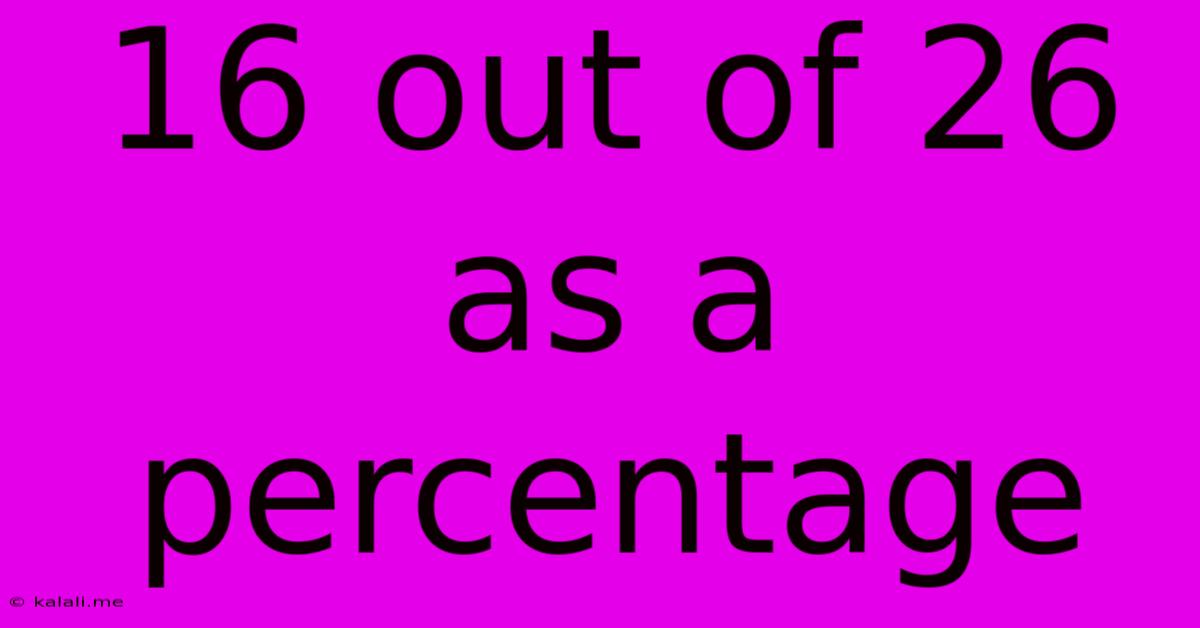16 Out Of 26 As A Percentage
Kalali
May 09, 2025 · 2 min read

Table of Contents
16 out of 26 as a Percentage: A Simple Calculation and Its Applications
Calculating percentages is a fundamental skill with widespread applications in various fields, from finance and academics to everyday life. This article will guide you through calculating "16 out of 26 as a percentage," explain the process step-by-step, and demonstrate its relevance in practical scenarios. Understanding this calculation can help you interpret data more effectively and make informed decisions.
Understanding the Basics of Percentages
A percentage is a fraction or ratio expressed as a number out of 100. The symbol "%" represents "percent" or "out of 100." For example, 50% means 50 out of 100, which simplifies to 1/2 or 0.5.
Calculating 16 out of 26 as a Percentage
To find the percentage, we follow these steps:
-
Create a Fraction: Express the problem as a fraction: 16/26. This represents 16 parts out of a total of 26 parts.
-
Convert to Decimal: Divide the numerator (16) by the denominator (26): 16 ÷ 26 ≈ 0.6154.
-
Convert to Percentage: Multiply the decimal by 100: 0.6154 × 100 ≈ 61.54%.
Therefore, 16 out of 26 is approximately 61.54%.
Rounding the Percentage
Depending on the context, you may need to round the percentage to a whole number or a specific number of decimal places. In this case, rounding to one decimal place gives us 61.5%. Rounding to the nearest whole number gives us 62%. The appropriate level of rounding depends on the desired precision.
Practical Applications
Understanding how to calculate percentages like "16 out of 26" has numerous real-world applications, including:
-
Academic Performance: If a student answered 16 out of 26 questions correctly on a test, their score would be approximately 61.5%.
-
Sales and Marketing: Businesses use percentages to track sales figures, conversion rates, and market share. For instance, if a company sold 16 out of 26 products, their sales rate would be 61.5%.
-
Financial Calculations: Percentages are crucial in calculating interest rates, discounts, taxes, and profit margins.
-
Data Analysis: Researchers use percentages to represent proportions and trends within datasets.
Beyond the Calculation: Understanding the Context
While the calculation itself is straightforward, it’s important to consider the context in which this percentage is used. The meaning and significance of 61.5% will depend heavily on the specific situation. For example, a 61.5% score on a test might be considered good, average, or poor, depending on the difficulty of the test and the grading scale.
In conclusion, converting 16 out of 26 into a percentage is a simple yet valuable skill with wide-ranging applicability. Mastering this calculation enhances your ability to interpret data, analyze situations, and make informed decisions in various aspects of life. Remember to always consider the context to fully understand the implications of the resulting percentage.
Latest Posts
Latest Posts
-
3 Decomposers In The Tropical Rainforest
May 09, 2025
-
Cuanto Son 30 Oz En Litros
May 09, 2025
-
How Much Is 48 Celsius In Fahrenheit
May 09, 2025
-
17 Out Of 20 As A Percent
May 09, 2025
-
Broom Is What Type Of Simple Machine
May 09, 2025
Related Post
Thank you for visiting our website which covers about 16 Out Of 26 As A Percentage . We hope the information provided has been useful to you. Feel free to contact us if you have any questions or need further assistance. See you next time and don't miss to bookmark.